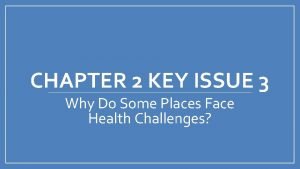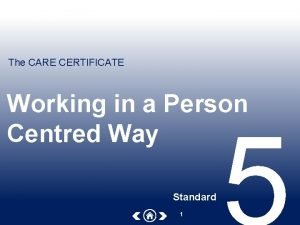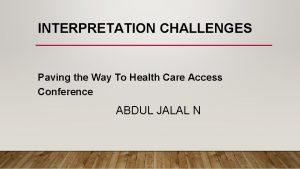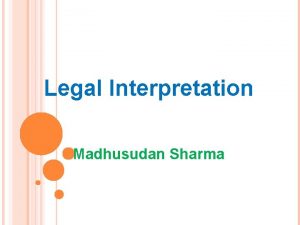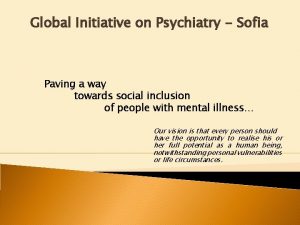INTERPRETATION CHALLENGES Paving the Way To Health Care


































- Slides: 34

INTERPRETATION CHALLENGES Paving the Way To Health Care Access Conference Omar Alsheikh, MB. CHB, MD, MPH


THE OBJECTIVES 1. Understanding who is the limited English proficient? 2. Basic information about the languages in the US 3. Arabic language, origin, etymology and types 4. Why the language barrier is an issue and what is it? 5. The scope of the problem 6. Title VI Civil Rights Act 1964 and the Joint of Commission recommendations about language services in Healthcare 7. Arabic interpreters challenges 8. Potential solutions

ARABIC SPEAKING COUNTRIES

SOME STATISTICS ABOUT ARABIC LANGUAGE • 420 million people around the world speak Arabic. • The sixth most spoken language. • The word “Arab” means ( different opinions about the origin of name) 1 - “Araba” region in Arabian Peninsula 2 - Yaarub Ben Qahtan 3 - Abarah from ﺍﻟﻌﺮﺑﻴﺔ ﺍﻟﺠﺰﻳﺮﺓ ﺷﺒﺔ ﻓﻲ ﺍﻟﺘﺮﺣﺎﻝ ﻟﻜﺜﺮﺓ - ﺍﻧﺘﻘﻞ ﺍﻱ ﻋﺒﺮ ﺍﻭ ﺇﻋﺮﺍﺏ 4 - “nomad”, which makes sense considering Arabic originated from nomadic tribes • Arabic is the official language of the 22 countries that form the Arab League. • Arabic is a Central Semitic language, closely related to Aramaic and Hebrew. -Standard or Classical Arabic – ﻓﺼﺤﻰ – is the distinct form of the language used in media, newspapers, literature and other formal settings. - ‘Aamiya ﻋﺎﻣﻩ , which is colloquial (spoken) Arabic, has many forms that are used in ordinary conversation, and it varies from country to country, and even town to town. Example in Western context: American English Vs British English.

ROOTS AND MEANING IN ARABIC • Arabic has a complex but beautiful method of constructing words from a basic root. For Example: ‘k-t-b’ ﻙ ﺏ ﺕ ﻳﻜﺘﺐ ‘writing ‘kitaab’ ﻛﺘﺎﺏ which means ‘a book’ and ‘maktab’ ﻭﻣﻜﺘﻮﺏ ﻣﻜﺘﺐ which means ‘a desk or office’ “ letter “ respectively. ﺍﻟﺜﻼﺛﺔ ﺍﻟﺤﺮﻭﻑ ﻟﻬﺬﻩ ﻛﺜﻴﺮﺓ ﺍﺷﺘﻘﺎﻗﺎﺕ ﻫﻨﺎﻙ Using the root system means that direct translation, particularly of poetic texts, is often difficult – the root of a word may contain a meaning that could take a few sentences to translate. However, this can be beneficial, and the beauty of it is that it conveys a depth of both meaning and emotion unmatched by many languages.

VARIOUS MEANINGS FOR ONE TERM AND ONE TERM WITH DIFFERENT MEANINGS • Love: Arabic has at least 11 words for love and each of them conveys a different stage in the process of falling in love. The word 'hawa’ ﻫﻮﻯ , for example, describes the initial attraction or inclining of the soul or mind towards another. The term comes from the root word ‘h-w-a’ - a transient wind that can rise and fall. • 'Alaaqa’ ﻋﻼﻕ , which comes from the root word (‘a-l-q) which means ‘to cling on to’ describes the next stage when the heart begins to attach itself to the beloved, before evolving into a blind desire 'ishq 'ﻋﺸﻖ and all-consuming love 'shaghaf 'ﺷﻐﻒ. The final stage of falling in love, 'huyum', describes the complete loss of reason. • Interestingly, the most common word for love in Arabic, 'hubb 'ﺣﺐ , comes from the same root as the word ‘seeds ’ﺣﺒﻮﺏ – that which has the potential to grow into something beautiful. • The word for heart, ‘qalb ﻗﻠﺐ Nor Kalb **’, comes from the root word (q-l-b), meaning to flip or turn something over. • ‘Trust in God, but tie up your camel’ is a great (and practical) Arabic proverb used to express the nature of destiny and personal responsibility. The matter of destiny is also very much embedded within everyday Arabic phrases such as ‘Insha’Allah’ (If God wills).

UNIQUENESS OF ARABIC 1 - Some sounds and phonetic 2 - Different Alphabet 3 - Direction of writing and calligraphy 4 - Tashkil -diacritics. The latter include the ḥarakāt ﺍﺕ - Literally “forming ﻳ ٱﻠ ﻡ ٱﻠﻠ Bismi Llāhi r-Raḥmāni r-Raḥīmi In the Name of God, the Most Gracious, the Most Merciful. . . There are many differences between Arabic and English, the most obvious one being that it is written from right to left. There also a few sounds that don’t exist in other languages, such as ' , ' ﺡ which is a ‘h’ sound as in ‘ ’ﺣﺐ (love).


LANGUAGE BARRIERS TO THE HEALTHCARE SYSTEM I THE US

THE UNITED STATES BECOMES INCREASINGLY DIVERSE AND BILINGUAL.

THE SCOPE OF THE PROBLEM • Several studies have found that patients who cannot speak English well receive less than optimal health care and are at greater risk of not receiving healthcare services: • LEPs are at greater risk of not receiving mammography, pap smear, breast ex, and other preventative services. • LEPs are less likely to have regular PCP. • LEPs have fewer visits and to return for f/u visits after seen in the ED. • LEPs are less likely to receive timely eye, dental and annual physical examinations. • LEPs are less likely to compliance with medical advice due to confusion. • LEPs are less satisfied with their healthcare and communication with the health care giver. _________ Source: Impact of Interpreter Services on Delivery of Health Care to Limited–English-proficient Patients, Jacobs et al, 2001.

WHAT ARE THE RELEVANT LAWS AND REGULATIONS CONCERNING LANGUAGE ACCESS FOR LEPS? 1 - Title VI of the Civil Rights Act of 1964. 2 - The Joint Commission Recommendations.

TITLE VI OF THE CIVIL RIGHTS ACT OF 1964. Federal laws particularly applicable to language access include Title VI of the Civil Rights Act of 1964, and the Title VI regulations, prohibiting discrimination based on national origin, and Executive Order 13166 issued in 2000. Many individual federal programs, states, and localities also have provisions requiring language services for limited English proficiency ( LEP) individuals. "Improving Access to Services for Persons with Limited English Proficiency. " The Executive Order requires Federal agencies to examine the services they provide, identify any need for services to those with LEP, and develop and implement a system to provide those services so LEP persons can have meaningful access to them.

THE JOINT COMMISSION RECOMMENDATIONS • It is An independent, not-for-profit organization, The Joint Commission accredits and certifies nearly 21, 000 health care organizations and programs in the United States that reflects an organization’s commitment to meeting certain performance standards. • The Joint Commission supports efforts to improve communication between health care professionals and patients. It’s been estimated that there are more than 300 languages spoken in the United States and more than 90 million Americans have low health literacy, meaning they have difficulty understanding and using health information. • The Joint Commission recommends an approach to communicating health information that encompasses language needs, individual understanding, and cultural and other communication issues. The Joint Commission requires that interpretation and translation services be provided as necessary. __________

THE COMPLEXITY OF THE CONSENT

WHY WE DO NOT ALWAYS HAVE LANGUAGE SERVICES? 1. The cost of the language services ( ranges $18 -50 per hour, average is $24 per hour this is for interpretation ) 2. Inadequate funding. 3. The cost of training to have qualified, certified or licensed medical interpreter or translator. (MIT: Medical Interpreter Training costs about $1000 for 60 hours training) 4. The high percentage of medical interpreters turnover. 5. Private payers also do not reimburse facilities for interpreter services. 6. Healthcare organizations can not hire medical interpreters for the all 300 language.

SOLUTIONS • On-site interpreters should be available for the most commonly spoken foreign languages during business hours and after business hours, a 24/7 language line service should be available. • Documents ( consents, brochure, discharge instruction, labs, etc. ) should be translated into different languages using simple language. • Healthcare websites should be available in different languages • Additional time should be scheduled for visits when language services are needed. • Healthcare providers need more education and training in using the various methods of interpretation effectively.

SOLUTIONS • Robot for Medical language services. • Google translate and we may have interpterion services. • Phone applications • Using universal symbols and language in the Healthcare. _________ Source: Proceedings of Machine Translation Summit XVI, Track Masaru Yamada, Mark Seligman, 2017

REGISTER The level of sophistication or the technicality in spoken language. Examples: Myocardial Infarction- High register Hart attack- Low register You might be having hyperglycemia. Low glucose diet is recommended You have high blood sugar. I advice you to cut back on sugar. Other examples? Why is register important?

COLLOQUIAL, MODERN STANDARD AND CLASSIC ARABIC • Classic Arabic ﺍﻟﻔﺼﺤﻰ ﺍﻟﻌﺮﺑﻴﺔ 'ﺍﻟﻠﻐﺔ the most eloquent Arabic language’. • Modern Standard Arabic (MSA), or Literary Arabic used in writing and in most formal speech throughout the Arab world to facilitate communication. • MSA is based on classical Arabic, and differences between the two varieties of the language are directly related to modernizing and simplification, both in speaking and writing styles. Most Arabic speakers consider the two varieties to be two registers of one language. • The largest differences between the classical/standard and the colloquial Arabic are the loss of grammatical case; a different and strict word order. • IS your Arabic MSA/ Classic acquired and learned or mother tongue? Why and why not.

GROUP SESSION • How to say these terms and sentence in your mother language: • Bread, water, tomato, rice, soup, spinach, fish and chicken. • Hi, goodbye, how are you? are you fine? You’re welcome. • I want that, I do not need this, write down your intials • Headache, flexion, extension, supination, abdominal pain, vomiting, diarrhea, dull pain, seizure, epilepsy, infection, mumps, tonsils, inflammation, emergency, urgency, hand, arm, walking clinic, break the water, concerns, forearm, X-ray, Ultrasound, MRI, CT-scan, blood test, fracture, sprain ad strain, nerves, lungs, breasts, eyes, mouth, objectives, goals, N/A ( Not applicable), advocacy, advocate scotch over, , .

EXAMPLES- CONTINUE 1 - Sore or soreness 2 - inflammation 3 - tenderness 4 - amnesia vs dementia 5 - aphasia 6 - bland diet 7 - high calories diet 8 - colostomy 9 - Mump 10 - concerns 11 - Advocacy

EXAMPLES CONTINUE • 1 - Sore or soreness 2 - inflammation 3 - tenderness 4 - amnesia vs dementia 5 - aphasia 6 - bland diet 7 - high calories diet 8 - colostomy 9 - Mump 10 - concerns 11 - Advocacy • Medical History • Antibodies and antigen- allergy- allergen. Blood thinner, Other examples?






ENGLISH ARABIC • Doctor: Cells have multiplied quickly in your son’s eye, forming a tumor in the retina. • Parent: A tumor? ! But I’m sure you can operate on the tumor and get it out , right? • Doctor: Well it is not that easy, the tumor has filled his eyeball. • Parent: What are you trying to tell me? You can’t operate on his eye? • Doctor: There are some treatments available. • Parent: Great, when do we start? • Doctor: Before I can discuss treatment, I must explain other things. Your son will be losing his sight and will become blind. We do not know how long this will take but we know he will not be able to see. I want you to understand this. • Parent: NO!!! THIS CAN’T BE HAPPENING!! NO!!! He loves to read and he’s learning how to drive. He wants to go to school and he wants to go to college! He’s a new student and he has a lot of dreams about his dreams. • Doctor: We will have to refer him to other specialists and make sure he receives special services in school since he is going to go blind. I am going to schedule him for an immediate follow up appointment with Dr. Good so he can discuss treatment with you. I recommend you set up an appointment as soon as possible.

• Nurse-practitioner: I want to explain the condition to you. Diabetes is a disease, but it’s also a condition and a way of living. I know it may seem a little frightening at first, but let me try to give you some basic information to help demystify the disease. Now, the first things to keep in mind is that in the child with Type 1 diabetes, which means insulin-dependent diabetes, the pancreas doesn’t produce insulin, and insulin is a hormone that’s necessary to sustain life. • Parent: You’re using words I do not understand. What do you mean insulin? Isn’t that the medicine? • Nurse-practitioner: No. Insulin in a hormone produces in the pancreas that regulates the level of glucose in the blood. • Parent: Now you really confused me. What is glucose? • Nurse-practitioner: Glucose means the sugar level in your child’s blood. Diabetic children can’t control the levels of glucose in their blood; sometimes it’s high and sometimes it’s slow. Insulin is an artificial hormone that can help him regulate these levels to have a healthy life. You’ll understand more as you become more familiar with it. • Parent: So what do I need to learn now? • Nurse-practitioner: Essentially, a person with Type 1 diabetes has to take injections of insulin to stay alive and healthy. And even then insulin isn’t a cure. It’s just a way of controlling the disease. So when a child with juvenile diabetes isn’t feeling well, you may want to look for certain kinds of symptoms… • Parent: You mean, he won’t be cured? Nurse-practitioner: No, I’m sorry.

COMPASSION IS A UNIVERSAL LANGUAGE Please remind yourself and your staff that even though the words may not get through, a genuine smile, touch and small gestures let a patient know is seen and cared about.


REFERENCES 1. https: //www. census. gov/ 2. https: //www. ncbi. nlm. nih. gov/pmc/articles/PMC 1495243/ 3. https: //www. jointcommission. org/facts_about_patient-centered_communications/ 4. http: //www. nejm. org/doi/full/10. 1056/NEJMp 058316 5. https: //www. ncbi. nlm. nih. gov/pmc/articles/PMC 3937896/ 6. http: //medicalfuturist. com/9 -exciting-medical-robot-facts/ 7. http: //www. nejm. org/doi/full/10. 1056/NEJMp 058316 8. http: //aamt. info/app-def/S-102/mtsummit/2017/wp-content/uploads/sites/2/2017/09/MTSummit. XVI_User. Track. pdf 9. http: //onlineresources. wnylc. net/pb/orcdocs/LARC_Resources/LEPTopics/DR/DR. htm 10. https: //www. hhs. gov/civil-rights/for-individuals/special-topics/limited-english-proficiency/index. html
 High desert paving
High desert paving Rsa paving
Rsa paving Bituminous paving conference
Bituminous paving conference Delta tc asphalt
Delta tc asphalt D norman paving
D norman paving Branscome paving company
Branscome paving company Sutter paving
Sutter paving How does interpretation b differ from interpretation a
How does interpretation b differ from interpretation a Primary secondary tertiary medical care
Primary secondary tertiary medical care Health and social care values unit 2
Health and social care values unit 2 Health and social component 3
Health and social component 3 Key issue 3 why do some places face health challenges
Key issue 3 why do some places face health challenges Marginal frequency
Marginal frequency Two way anova
Two way anova What is threaded binary tree
What is threaded binary tree Perbedaan one way anova dan two way anova
Perbedaan one way anova dan two way anova One way anova null hypothesis
One way anova null hypothesis One way anova vs two way anova
One way anova vs two way anova Contoh soal anova two way
Contoh soal anova two way The old way and the new way
The old way and the new way When i was one i had just begun the day i went to sea
When i was one i had just begun the day i went to sea Walk this way talk this way
Walk this way talk this way Work in a person centred way care certificate
Work in a person centred way care certificate Hát kết hợp bộ gõ cơ thể
Hát kết hợp bộ gõ cơ thể Frameset trong html5
Frameset trong html5 Bổ thể
Bổ thể Tỉ lệ cơ thể trẻ em
Tỉ lệ cơ thể trẻ em Gấu đi như thế nào
Gấu đi như thế nào Chụp tư thế worms-breton
Chụp tư thế worms-breton Chúa yêu trần thế alleluia
Chúa yêu trần thế alleluia Kể tên các môn thể thao
Kể tên các môn thể thao Thế nào là hệ số cao nhất
Thế nào là hệ số cao nhất Các châu lục và đại dương trên thế giới
Các châu lục và đại dương trên thế giới Công của trọng lực
Công của trọng lực Trời xanh đây là của chúng ta thể thơ
Trời xanh đây là của chúng ta thể thơ











